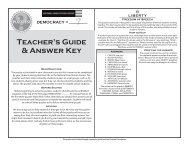YES NO - National Constitution Center
YES NO - National Constitution Center
YES NO - National Constitution Center
You also want an ePaper? Increase the reach of your titles
YUMPU automatically turns print PDFs into web optimized ePapers that Google loves.
www.constitutioncenter.org/exchange<br />
Should a clean and healthy<br />
environment be a<br />
constitutional right?<br />
“The natural resources of the nation are the heritage of present and future generations.<br />
The right of each person to clean and healthful air and water, and to the protection<br />
of the other natural resources of the nation, shall not be infringed upon by any person.”<br />
—Proposed Amendment to the U.S. <strong>Constitution</strong> (1996)<br />
With climate change and dependence on foreign oil high on<br />
the national agenda, environmental issues are being debated in<br />
Washington and across the country.<br />
Environmental concerns—and<br />
legislation to address them—are<br />
nothing new. From President Theodore<br />
Roosevelt’s conservation efforts to<br />
President Barack Obama’s policies<br />
for addressing global climate change,<br />
environmental issues have been at the<br />
forefront of presidential policy. Public<br />
concern for the environment established<br />
Earth Day in 1970, led to the passage of<br />
the Clean Air Act of 1970 and creation<br />
of the Environmental Protection Agency,<br />
an executive agency charged with<br />
safeguarding the natural environment.<br />
The debate over the environment has grown evermore complex,<br />
involving issues of climate-change, economic trade-offs and<br />
policies such as “cap and trade,” a market-based plan to steadily<br />
reduce carbon dioxide and other greenhouse gas emissions. The<br />
debate over global climate change has called into question the<br />
effectiveness and necessity of existing<br />
environmental legislation.<br />
One of the legacies of the environmental<br />
movement was to enshrine protection of<br />
the environment in the constitutions of<br />
several states, including Hawaii, Illinois,<br />
Pennsylvania, Massachusetts and<br />
Montana. But proposals to enact a federal<br />
constitutional amendment have never<br />
succeeded. Proponents of an amendment<br />
say it would have great symbolic value<br />
and lead to stronger environmental<br />
protection laws. Opponents say the<br />
<strong>Constitution</strong> already gives Congress the<br />
power it needs and that an amendment<br />
could divert resources from other social goods like a strong economy,<br />
quality healthcare and a good education.<br />
Now it’s your turn to answer the question:<br />
Should a clean and healthy environment be a constitutional right?<br />
<strong>YES</strong><br />
• A constitutional amendment would increase the role of the<br />
federal government and help to control pollution that knows<br />
no state boundaries.<br />
• A constitutional amendment would give Congress and the<br />
courts the clear authority to take strong action to protect<br />
the environment.<br />
• Recognizing a clean and healthy environment as a<br />
constitutional right will help the economy by creating more<br />
business opportunities, which will increase the number of jobs.<br />
<strong>NO</strong><br />
• A constitutional amendment would overturn the presumption<br />
in federal environmental statutes that the primary responsibility<br />
for environmental protection lies with the states.<br />
• The <strong>Constitution</strong>’s Commerce Clause gives the federal and<br />
state governments all the authority needed to protect<br />
the environment.<br />
• Recognizing a clean and healthy environment as a constitutional<br />
right will hurt the economy by increasing the cost of doing business<br />
and will result in the loss of jobs and a rise in consumer prices.
United States <strong>Constitution</strong><br />
Article I Section 8 Clause 3<br />
Article V<br />
The Environmental Commerce Clause (Excerpts)<br />
Christine A. Klein<br />
STUDENT HANDOUT<br />
The Congress shall have power…To regulate commerce with foreign nations, and among the<br />
several states, and with the Indian tribes;<br />
The Congress, whenever two thirds of both houses shall deem it necessary, shall propose<br />
amendments to this <strong>Constitution</strong>, or, on the application of the legislatures of two thirds of<br />
the several states, shall call a convention for proposing amendments, which, in either case,<br />
shall be valid to all intents and purposes, as part of this <strong>Constitution</strong>, when ratified by the<br />
legislatures of three fourths of the several states, or by conventions in three fourths thereof,<br />
as the one or the other mode of ratification may be proposed by the Congress; provided that<br />
no amendment which may be made prior to the year one thousand eight hundred and eight<br />
shall in any manner affect the first and fourth clauses in the ninth section of the first article;<br />
and that no state, without its consent, shall be deprived of its equal suffrage in the Senate.<br />
To learn more, visit the <strong>National</strong> <strong>Constitution</strong> <strong>Center</strong>’s Interactive <strong>Constitution</strong> at:<br />
http://constitutioncenter.org/<strong>Constitution</strong><br />
[F]ederal environmental law may be particularly vulnerable to the Court’s shrinking view of commerce clause authority because<br />
environmental protection frequently requires the regulation of intrastate, noneconomic activities.<br />
In some instances, states may seek to protect the health and safety of their residents by excluding harmful items such as solid<br />
waste or nonnative fish parasites, and retaining within their borders important resources such as water and indigenous fish<br />
species. Such state efforts may have economic consequences for the free market and economic benefits for the regulating state,<br />
thus treading perilously close to the Court’s expanding view of economic protectionism forbidden under the commerce clause.<br />
The Court effectively treats the environment as neither commodity nor natural resource, thus frustrating both federal and state<br />
efforts to protect the natural environment.<br />
With only one exception, the Court has invalidated every natural resource protection regulation that it has considered between<br />
1978 and 2001 in the context of a commerce clause challenge.<br />
[D]espite its rhetoric that land and water regulation are areas reserved to the states, the Court’s dormant commerce holdings have<br />
limited the states’ ability to enact such legislation in every case that has come before the Court.<br />
The modern Court’s shrinkage of federal and state legislative power under the commerce clause is ironic for its purported<br />
protection of economic freedom, achieved at the expense of legislative freedom. The commerce clause cases are part of a broader<br />
pattern under which the Court has become increasingly distrustful of legislative enactments at both the state and federal<br />
levels of government.<br />
[I]n appropriate cases, environmental regulation by one—or even both—sovereigns (i.e., federal and state) should be left<br />
undisturbed by the courts. This is not a radical proposition.<br />
Furthermore, there is considerable historical evidence that the Framers did not intend for the affirmative commerce clause to be<br />
exclusive, nor for the Court, rather than the political process, to be the final arbiter of the balance between federal and state power.<br />
Congress itself has advanced the idea of “cooperative federalism,” a principle that forms the basis of numerous environmental<br />
statutes including the Clean Air Act, the Clean Water Act, and the Resource Conservation and Recovery Act.<br />
Klein, Christine A., The Environmental Commerce Clause(2003). Harvard Environmental Law Review, Vol. 21, No. 1, 2003.<br />
Available at SSRN: http://ssrn.com/abstract=1273418<br />
Clean Air Act (Excerpts)<br />
The Clean Air Act is the law that defines EPA’s responsibilities for protecting and improving the nation’s air quality and the stratospheric<br />
ozone layer. The last major change in the law, the Clean Air Act Amendments of 1990, was enacted by Congress in 1990. Legislation passed<br />
since then has made several minor changes.<br />
The Clean Air Act (CAA) is the comprehensive federal law that regulates air emissions from stationary sources (like chemical plants,<br />
gas stations, and power plants) and mobile sources (like cars, trucks, and planes). Among other things, this law authorizes EPA to<br />
establish <strong>National</strong> Ambient Air Quality Standards (NAAQS) to protect public health and public welfare and to regulate emissions of<br />
hazardous air pollutants.<br />
[T]here was no comprehensive federal response to address air pollution until Congress passed [the] Clean Air Act in 1970. That same year<br />
Congress created the EPA and gave it the primary role in carrying out the law. Since 1970, EPA has been responsible for a variety of Clean<br />
Air Act programs to reduce air pollution nationwide.<br />
In 1990, Congress dramatically revised and expanded the Clean Air Act, providing EPA even broader authority to implement and enforce<br />
regulations reducing air pollutant emissions. The 1990 Amendments also placed an increased emphasis on more cost-effective approaches<br />
to reduce air pollution.<br />
Specifically the new law:<br />
• Encourages the use of market-based principles and other innovative approaches, like performance-based<br />
standards and emission banking and trading;<br />
• Provides a framework from which alternative clean fuels will be used by setting standards in the fleet<br />
and California pilot program that can be met by the most cost-effective combination of fuels and technology;<br />
• Promotes the use of clean low sulfur coal and natural gas, as well as innovative technologies to clean high sulfur coal<br />
through the acid rain program;<br />
• Reduces enough energy waste and creates enough of a market for clean fuels derived from grain and natural gas<br />
to cut dependency on oil imports by one million barrels [per] day;<br />
Available online at: http://www.epa.gov/air/caa/<br />
Calculating the Cost of Environmental Regulation (Excerpts)<br />
STUDENT HANDOUT<br />
As pollution control moves away from end-of-pipe abatement and toward pollution prevention and process changes, it becomes increasingly<br />
difficult to identify the operating costs associated with environmental protection. Even worse, as we turn to research and new technology<br />
to provide cleaner alternatives to polluting activities, the cost of these research and development activities is virtually unknown.<br />
In retrospective studies, it is difficult to know what improvements may have occurred elsewhere in the absence of environmentally focused<br />
R&D [research and development] activities. In prospective studies, it is difficult to know how much improved technologies will cost.<br />
Consider the example of global climate policy and, particularly, efforts to reduce carbon dioxide emissions. Economists would agree that in<br />
general, effective policies to limit carbon dioxide emissions should raise the private of cost of carbon emitted into the atmosphere in the short<br />
run (through the use of tax or “cap and trade” systems). The price rise will stimulate conservation of carbon-containing fuels and provide<br />
incentives for the development of non-carbon energy technologies in the future. The price increases will also have a dynamic effect on the<br />
distribution of resources devoted to research and development, innovation, and commercialization, with relatively more resources going to<br />
carbon-saving research and less elsewhere. What we do not know, and have only begun to conceptualize, is the effect of this altered resource<br />
distribution on social welfare. Will resources be diverted from medical research, nanotechnology, and telecommunications? And if they are,<br />
what social gains have we lost so that we can have carbon-free energy?<br />
“Calculating the Costs of Environmental Regulation,” (with William A. Pizer) in Handbook of Environmental Economics, Volume III,<br />
(K.G. Maler and J.R. Vincent, editors) Elsevier 2005. Available online at: http://www.rff.org/Documents/RFF-DP-03-06.pdf<br />
Grades:<br />
High School<br />
Classroom Time:<br />
one 45 minute class period<br />
<strong>Constitution</strong> Connections:<br />
Article I section 8 clause 3<br />
Article V<br />
Articles Included:<br />
• The Environmental<br />
Commerce Clause<br />
• Cap and Trade<br />
• Transcript of President<br />
Obama Video Message<br />
to the Governors’ Global<br />
Climate Summit<br />
• Clean Air Act<br />
• Calculating the Cost of<br />
Environmental Regulation<br />
ADVICE TO STUDENTS FOR CONSTITUTIONAL DELIBERATION<br />
The <strong>National</strong> <strong>Constitution</strong> <strong>Center</strong> is located in Philadelphia, just a few steps from Independence Hall, where the <strong>Constitution</strong><br />
of the United States was written and signed during the summer of 1787. The men who came to Philadelphia that summer did<br />
so because they knew the direction of the country they loved needed to change. They deliberated for nearly four months and<br />
created a document that none thought was perfect. But they put forward a challenge to future generations: keep working<br />
towards the creation of a “more perfect Union.” The <strong>Center</strong> was created to support this challenge and encourages visitors to<br />
walk in the steps of the founders and deliberate the future of our country.<br />
The guidelines presented below have been created to provide you with advice and ideas on how to both present your arguments<br />
and hear those of others. The advice below was inspired by the rules adopted by the <strong>Constitution</strong>al Convention, as presented by<br />
George Wyeth of Virginia on May 28, 1787.<br />
• Think through your idea before presenting it to the group; you may wish to make a few notes on paper to ensure your idea is clear.<br />
• Listen carefully to other ideas and consider how to incorporate them into your own.<br />
• When you are not speaking, do not have other side conversations, read a book or document, or distract the speaker in another way.<br />
• When challenging an idea, focus on the idea, not the person you are challenging.<br />
• Use the <strong>Constitution</strong> as support for your ideas; refer to the text and use it as a tool to support your argument.<br />
• Do not dominate the conversation, and do not speak more than twice before allowing everyone else the<br />
opportunity to be heard.<br />
• Present you ideas directly to the facilitator or group leader.<br />
• When developing your argument, consider the position of the other side, and use these ideas to support or<br />
build compromise into your position.<br />
• Wait to be acknowledged by the facilitator before speaking.<br />
INTRODUCTION<br />
Author:<br />
Jason E. Allen, <strong>National</strong> Student Programs Manager, <strong>National</strong> <strong>Constitution</strong> <strong>Center</strong><br />
Scholarly Advisors:<br />
J. Michael Hogan, Ph.D; David N. Cassuto, Professor of Law;<br />
James R. May, Professor of Law;<br />
Jeffrey G. Miller, Vice Dean for Academic Affairs and Professor of Law<br />
About this lesson<br />
This research and deliberation activity is designed to encourage students to look at the<br />
issue of climate change and environmental regulation from a constitutional perspective and<br />
then to find political and economic measures to address environmental regulation. In any<br />
deliberation activity, compromise and listening will play a key role in finding common ground.<br />
Objectives<br />
Students will be able to evaluate multiple perspectives on the issues and determine what<br />
can be done to find common ground between those who believe that a clean and healthy<br />
environment should be a constitutional right and those who believe it to be unnecessary<br />
to amend the <strong>Constitution</strong> to ensure a clean and healthy environment.<br />
Resources<br />
Links to the articles used in this lesson and extension readings for this lesson are available<br />
at the <strong>National</strong> <strong>Constitution</strong> <strong>Center</strong>’s website at: www.constitutioncenter.org/exchange.<br />
Transcript: Obama Video Message to the Governors’<br />
Global Climate Summit (Excerpts)<br />
Climate change and our dependence on foreign oil, if left unaddressed, will continue to weaken our economy<br />
and threaten our national security.<br />
My presidency will mark a new chapter in America’s leadership on climate change that will strengthen our security<br />
and create millions of new jobs in the process.<br />
That will start with a federal cap and trade system. We will establish strong annual targets that set us on a course to reduce<br />
emissions to their 1990 levels by 2020 and reduce them an additional 80% by 2050. Further, we will invest $15 billion each year<br />
to catalyze private sector efforts to build a clean energy future. We will invest in solar power, wind power, and next generation<br />
bio-fuels. We will tap nuclear power, while making sure it’s safe. And we will develop clean coal technologies.<br />
This investment will not only help us reduce our dependence on foreign oil, making the United States more secure. And it will not<br />
only help us bring about a clean energy future, saving our planet. It will also help us transform our industries and steer our country<br />
out of this economic crisis by generating five million new green jobs that pay well and can’t be outsourced.<br />
But the truth is the United States cannot meet this challenge alone. Solving this problem will require all of us working together.<br />
And I look forward to working with all nations to meet this challenge in the coming years.<br />
Stopping climate change won’t be easy. It won’t happen overnight. But I promise you this: Any company that’s willing to invest in<br />
clean energy will have an ally in Washington. And any nation that’s willing to join the cause of combating climate change will have<br />
an ally in the United States of America. Thank You.<br />
Available online at:<br />
http://change.gov/newsroom/entry/president_elect_barack_obama_to_deliver_taped_greeting_to_bi_partisan_gover/<br />
Cap and Trade<br />
Cap and Trade is a market-based policy tool for protecting human health and the environment. A cap and trade program first sets<br />
an aggressive cap, or maximum limit, on emissions. Sources [polluters] covered by the program then receive authorizations to<br />
emit in the form of emissions allowances, with the total amount of allowances limited by the cap. Each source can design its own<br />
compliance strategy to meet the overall reduction requirement, including sale or purchase of allowances, installation of pollution<br />
controls, implementation of efficiency measures, among other options. Individual control requirements are not specified under a<br />
cap and trade program, but each emissions source must surrender allowances equal to its actual emissions in order to comply.<br />
Sources must also completely and accurately measure and report all emissions in a timely manner to guarantee that the overall<br />
cap is achieved.<br />
A Well Designed Program Provides:<br />
• Strict limits on emissions yielding dramatic pollution reductions;<br />
• High levels of compliance, transparency, and complete accountability;<br />
• Regulatory certainty and flexibility for sources;<br />
• Incentives for early pollution reduction and innovations in control technologies;<br />
• Compatibility with state and local programs;<br />
• Significant, widespread, and guaranteed human health and environmental benefits;<br />
• Efficient use of government resources, and<br />
• More benefits at less cost.<br />
Available online at: http://www.epa.gov/airmarkets/cap-trade/<br />
STUDENT HANDOUT<br />
WE THE PEOPLE<br />
Our country faces enormous challenges both foreign and domestic. We need citizens who believe that<br />
democracy demands more than voting in November. A sustainable democracy needs citizens who believe<br />
in taking part in our nation’s political, social and economic discourse. The responsibility for maintaining a<br />
democracy that protects the freedoms enshrined in our <strong>Constitution</strong> is in the hands of the people.<br />
This is why Abraham Lincoln’s words 145 years ago still ring true today:<br />
“…government of the people,<br />
by the people, for the people…”<br />
BE HEARD<br />
Now your students can experience an innovative way to deliberate current constitutional issues with other<br />
high school students across the nation that is free of charge.<br />
The Exchange is a dynamic way for high school students to discover how their peers in their classroom and<br />
other parts of the country view important issues facing the nation. Past topics include Religion in Public<br />
Schools, School Safety, Important Issues Facing the Nation in 2008, Setting the Student Political Platform<br />
for the 2008 Presidential Election and Is the <strong>Constitution</strong> Color-blind?<br />
All you need to get involved is…<br />
• Interest in deliberating current events in your classroom<br />
• Interest in constitutional issues<br />
• Internet connectivity<br />
Join the nationwide conversation by…<br />
• Downloading the free curriculum and educational resources we provide<br />
• Viewing or participating in the live Internet Web cast<br />
• Taking part in our moderated online chat and forum<br />
Join the conversation online at:<br />
www.constitutioncenter.org/exchange<br />
A supplement to The New York Times Upfront / Scholastic Inc.<br />
Printed in the USA. The New York Times Upfront, Scholastic and associated designs are trademarks/registered trademarks of Scholastic Inc. Permission is granted<br />
to teachers to reproduce student handouts for their individual classroom use only. No other parts of this publication may be reproduced in whole or in part in any<br />
form or format without special permission from the publisher.<br />
The <strong>National</strong> <strong>Constitution</strong> <strong>Center</strong> and associated designs are trademarks/registered trademarks of the <strong>National</strong> <strong>Constitution</strong> <strong>Center</strong>.<br />
Permission is granted to teachers to reproduce student handouts for their individual classroom use only. No other parts of this publication may be reproduced<br />
in whole or in part in any form or format without special permission from the <strong>National</strong> <strong>Constitution</strong> <strong>Center</strong>.<br />
Education<br />
NATIONAL CONSTITUTION N CENTER<br />
look. learn. act.<br />
“Should a clean<br />
and healthy environment<br />
be a constitutional right?”<br />
Poster<br />
LESSON<br />
OPENING<br />
1. Ask your students to work individually to answer the following two questions.<br />
Then, ask them to share their answers with the class.<br />
Q: How do you feel about the debate over climate change?<br />
Students should base their opinion on their interpretation of the issue.<br />
Q: Why do you feel this way about the debate over climate change?<br />
Students should infer values connected to the issue.<br />
2. Display the Town Hall Wall so that all of your students can see the poster. Next, ask them to first read the<br />
short description of the issue and then answer the question with a simple Yes or No on Post-it notes<br />
placed on the Town Hall Wall.<br />
Q: Should a clean and healthy environment be a constitutional right?<br />
Students are to answer Yes or No.<br />
3. Ask your students to share their answers to the following three questions with the class and display their<br />
answers for the class to see. Your students should write the answers in their notebooks for use in<br />
Step 6 and 7.<br />
Q: What values are associated with those who answered Yes?<br />
Students should list political principles or standards which they believe influence this choice.<br />
Q: What values are associated with those who answered No?<br />
Students should list political principles or standards which they believe influence this choice.<br />
Q: What values do you think both perspectives have in common?<br />
Students should list political principles or standards which influence both choices.<br />
INVESTIGATION<br />
4. Divide your students into groups of three or six students and provide each group with the following articles.<br />
Assign each student one of the topics highlighted below and the readings for that topic. Using the provided<br />
documents, ask each student to answer their assigned questions in their notebooks. Then, have each group<br />
share their answers with the class. Record their answers on the board. Your students should write the<br />
answers on the board in their notebooks<br />
for use in Steps 5, 6 and 7.<br />
Amend the <strong>Constitution</strong>: Article I section 8 clause 3, the Commerce Clause, and Article V and<br />
The Environmental Commerce Clause<br />
Q: Why should there be an environmental amendment to the <strong>Constitution</strong>?<br />
Q: Why should there not be an environmental amendment?<br />
Q: What evidence do you have to support your answers?<br />
Retain the existing policy: Clean Air Act and Calculating the Cost of Environmental Regulation<br />
Q: Why is the Clean Air Act all that is necessary to protect the environment?<br />
Q: Why is the Clean Air Act not all that is necessary??<br />
Q: What evidence do you have to support your answer?<br />
Implement a new policy: Cap and Trade and the transcript of Barack Obama’s<br />
Video Message to the Governors’ Global Climate Summit<br />
Q: Why should a Cap and Trade policy be put in place?<br />
Q: Why should Cap and Trade not be put in place?<br />
Q: What evidence do you have to support your answer?<br />
INVENTORY<br />
5. Staying in their group, ask each student to find two or three pieces of evidence collected in Step 4 that<br />
supports their answer to the Town Hall Wall question. Ask your students to record the evidence in their<br />
notebooks and share them with the group. This evidence will be used in Step 6.<br />
6. Staying in their group, ask each student to answer the following three questions in their notebooks using<br />
values from Step 3 and evidence from Step 5. Once your students have completed the three questions,<br />
have them compare their findings with other group members.<br />
Q: What values do you and those who support your perspective on climate change have in common?<br />
Q: What evidence do you have to support your perspective?<br />
Q: What might be the political, economic and environmental consequences of doing<br />
what you are suggesting?<br />
7. Have the groups brainstorm answers to the following three questions using values from Step 3 and<br />
evidence from Step 5. Have one member of each group record their group’s answers to the questions<br />
below and then present the group’s answers to the class.<br />
Q: What values do people who support a perspective different from your own on climate<br />
change have in common?<br />
Q: What evidence would support their perspective?<br />
Q: For those who have a different perspective, what could be the political, economic<br />
and environmental consequences of doing what they have suggested?<br />
DELIBERATION<br />
8. Have all of the groups present their final ideas on the following questions to the class. Record their<br />
answers for the class to see. If the same answer is given more than once, then mark it with a star to<br />
determine which answer the majority of the class agrees with and use these answers for Step 9.<br />
Q: Why should a clean and healthy environment be a constitutional right?<br />
Ask your students to use values that have previously been listed to support their answer.<br />
Q: Why should a Cap and Trade policy to protect the environment be put in place?<br />
Ask your students to use values that have previously been listed to support their answer.<br />
Q: Why should existing legislation under the Clean Air Act be the only laws in place<br />
to protect the environment?<br />
Ask your students to use values that have previously been listed to support their answer.<br />
Q: What values do all of these perspectives have in common?<br />
Ask your students to use values that have previously been listed to support their answer.<br />
9. As a class, ask your students to craft a class Compromise Statement, which is a statement that is<br />
negotiated among supporters of each perspective. The statement includes the values all the perspectives<br />
have in common, and evidence that supports each perspective. Encourage the class to work towards<br />
an answer to the question posed at the start of the lesson: Should a clean and healthy environment be a<br />
constitutional right? in their Compromise Statement.<br />
10. Class Compromise Statements can be uploaded to: www.exchangeideas.org<br />
for students around the country to view as part of our on going conversation at The Exchange.


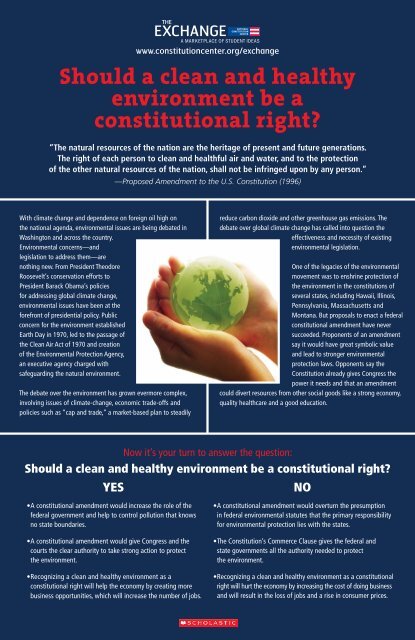
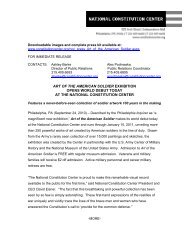

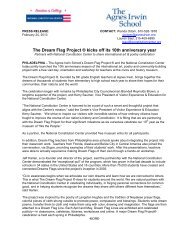
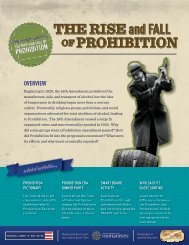


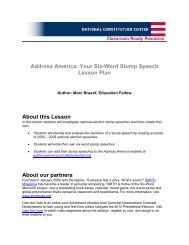


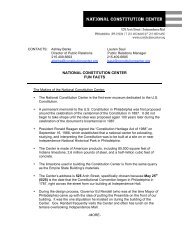
![Preamble Scramble [PDF] - National Constitution Center](https://img.yumpu.com/33840276/1/190x245/preamble-scramble-pdf-national-constitution-center.jpg?quality=85)
